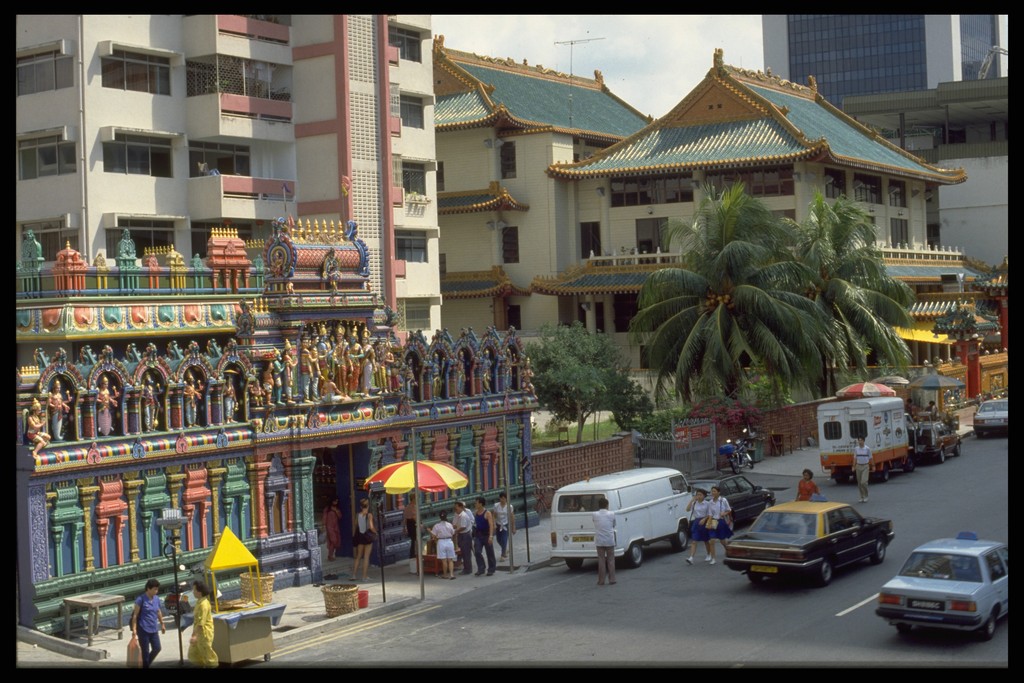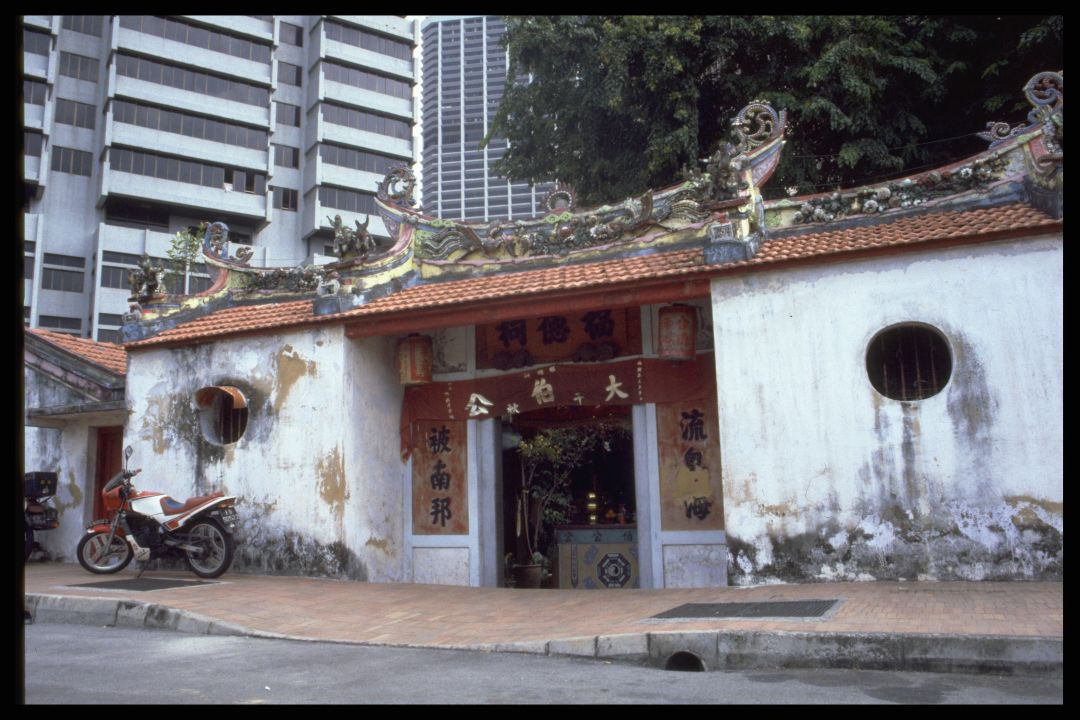新加坡华人社群的圣墓和拿督崇拜
新加坡的华人宗教实践虽然源于传统中国的意识形态、文本和仪式习俗,但同时也具有极强的适应性。华人宗教实践与华人所生活的社区经过长期互动,演变为当地华人社群特有的宗教实践。以新加坡而言,伊斯兰教传入前后留存的圣墓、圣迹(以下简称圣墓崇拜)1和马来文化中本土神灵的人格化“拿督”的崇拜,在新加坡华人社群中普遍存在。圣墓和拿督崇拜在马来群岛的华人社区中很常见,在海峡殖民地(即槟城、马六甲和新加坡)尤其流行,街边神龛和庙宇中都可以见到受供奉的圣墓和拿督。这些神龛大多遵循伊斯兰习俗,例如不能以猪肉为供品等。
圣墓和拿督
严格来说,圣墓崇拜和拿督公崇拜是两种不同的信仰。马来语的“Keramat”意思为“圣物”或“奇迹”,指的是成为圣者的人的坟墓、与圣者有关的物体、以及其他有神奇力量的生物,例如树、老虎和鳄鱼。2随着供奉马来回教圣者的圣墓在新加坡持续增加,华人信徒也会前往朝拜。动物崇拜,虽然如今较少耳闻,将有灵性的动物作为地方守护神供奉的例子并不少见。在1960年,双溪加株和武吉班让的渔民,在每日出发工作前必先向一只鳄鱼叩拜,以求工作平安。3


与圣墓崇拜不同,拿督公和拿督奶奶是华人对当地神灵或守护神的称呼。这些神明通常具有马来回教的特征。拿督公有时会与华人神明如土地公或大伯公(也称为福德正神)相提并论。圣墓崇拜和拿督崇拜之间的界限相对游移,因为两者在不同的历史和宗教语境中可能有重叠之处。例如,龟屿马来神祠供奉的赛阿都拉曼(生卒年不详)以及他的母亲和妹妹分别被称为“拿督公”和“拿督奶奶”,在“拿督”后面加上了华人宗教中对神明的尊称“公”和“奶奶”。4
回溯历史
虽然新加坡华人时至今日仍在实践者圣墓和拿督崇祀,没有明确的证据表明这一习俗源于何时。在早期殖民地时代,约翰·克劳福(1783-1868)注意到伊斯干达·沙(1370-1424,一般认为是马六甲开国君主)的坟墓上建起了一座建筑:“人们建了一座简陋的建筑……回教徒、印度教徒和华人都来朝拜这座圣墓”。5前来朝拜的主要是华人,有记载称,莱佛士(1781-1826)的秘书曾敦促威廉·法夸尔(1774-1839)阻止华人在此处燃放炮竹。6
在1950年代,人类学家埃利奥特(生卒年不详)记录了拿督崇拜的跳乩仪式。7他发现,新加坡曾有过许多圣墓,但如今大多数已经消失了。例如,樟宜路上段的印度回教徒比斯米拉·瓦利(生年不详-1962)圣墓曾经拥有众多华人和非华人信徒,与哈比诺圣墓不相上下,但在1979年的重建计划中被拆除了。8

然而,也有一些圣墓至今仍有许多新加坡华人前去朝拜。例如,龟屿每年都吸引数以千计的各族群信徒前往朝拜。朝拜当天,信徒不能食用猪肉,很多华人信徒在山脚拜完大伯公后,拾级而上到山顶朝拜圣墓。本地的闽籍侨领章芳琳(1841-1893)曾指出,农历九月期间的龟屿进香非常盛行,使龟屿成为一处宗教圣地。9
崇祀原因
本地华人崇拜圣墓和拿督公的原因有很多。通常,神明因其灵验事迹而被崇祀。例如,阿拉伯商人哈比诺(1788-1866)在世时,据说常常显示神迹,因此,他的信徒不仅有本地的印度回教信徒,还包括不少华人。口述历史记录显示,哈比诺生前喜欢在珀玛路山脚下的望海大伯公庙观看酬神大戏,因此在他死后,他的圣墓立于望海大伯公庙附近10如今,许多华人信徒在望海大伯公庙拜拜后,会到访隔壁的回教堂和圣墓,并乐捐以示支持。

圣墓和拿督崇拜中具有来自不同信仰体系的象征,反映了新加坡作为一个多元族群和多元宗教社会具有丰富的宗教文化传统。例如,据称,华人富商王水斗(生活于1920年代,生卒年不详)曾通过华人乩童何明发(生卒年不详)与一位女性圣者交流,随后他出资赞助了龟屿圣墓的修复工作。圣墓石碑上分别刻有华文、阿拉伯文和马来文的碑文,反映了其特殊背景。11值得注意的是,并非所有拿督都是马来人或印度回教徒。例如,乌敏岛有一座德国姑娘庙,供奉的是一名身世不明的德裔少女,她被信徒称为“拿督娘娘”。12
社会学家认为,拿督崇拜反映了马来世界的跨族群交流,说明华人信徒在扎根本土的过程中,与占主导地位的马来回教徒群体持续进行互动,并协商宗教虔信的空间,逐步形成了具有多元文化特征的华人宗教实践。这种跨越族群和宗教边界的信仰整合,让华人得以选取与之共鸣的宇宙观及信仰,并灵活地与之沟通。13在多元族群社会中,来自不同族群和宗教背景的神明共同受到供奉的情况并不少见。一个典型的例子是洛阳大伯公宫,其中有三个独立的神龛,分别供奉大伯公、拿督公和印度象头神。14
拿督公的表现形式
拿督公与圣墓一样,有多种不同的表现形式,难以明确分类。例如,在樟宜、实乞纳和景万岸的拿督庙中,拿督的象征是如树木之类的自然物,通常用黄布包裹着树木或神龛来作为辨识。拿督也可能以形状奇特的石头之类的形象出现,例如直落布兰雅天宫庙的拿督公是一块雕刻精美的瓷砖,而盛港忠义庙的拿督公则是一块以花环装饰的、人神化的石头。
在一些本地华人庙宇中,大伯公的形象也与拿督公异曲同工,身穿马来服饰如纱笼、头戴宋谷帽,反映了华人信徒视神明为本土灵体。这类神坛的设计风格,也吸收了回教的符号和建筑特点,如星月标志和圆顶。



拿督公被视为守护当地社区和信徒的本土神明。例如,榜鹅拿督神龛附近的巴士总站修建时,拿督公面临重置的问题。最终,人们建起一座神龛供奉拿督公,后来又增加了一张象头神的画像。同样,九条桥新芭拿督坛的主殿中供奉着大伯公和象头神,拿督公被供奉在另一个房间中,房间装饰如同洞穴,其中有瀑布和乌龟模型,拿督公身穿马来服饰。15大巴窑慈恩阁被视为拿督公神坛,因为那里生长的树被黄色的布包裹着。据说在大巴窑重建期间,这棵树不让机器将其推倒。如今,其树根已与神坛融为一体,底部还建有一座陪祀的拿督神龛。

并非所有的华人寺庙最初都有供奉拿督公,可能是机缘巧合之下才设拿督公神龛。位于惹兰乌鲁实乞纳街的金山寺,就是一例。据庙里的长辈说,拿督公显灵,通过庙里的一位土生华人起乩,要求在金山寺中建一座拿督公神龛。神龛建好后,拿督公才不再出现。同样的,供奉哪吒三太子的天德宫最初位于马里士他,后来庙宇搬迁,哪吒三太子降乩指示信徒迎请他在旧址的伙伴——一位拿督公——到新庙址,天德宫自此开始供奉拿督公。在这两个例子中,拿督神龛的建立,显示拿督公既是社区不可分割的一部分,同时也具有足够的灵活性和流动性,必要时可以加入或跟着迁移。
圣墓和拿督崇拜标志着新加坡华人宗教的多元融合,反映了新加坡位于南亚、东亚和东南亚的十字路口的特殊地位。尽管有些圣墓和拿督公神祠逐渐式微,不再如以往活跃,他们仍是新加坡多元文化互动和多元宗教的融合的典型体现。华人宗教吸收了其他宗教元素,体现了在地传统的适应性和包容性。拿督公和圣墓崇拜是新加坡华人尊重和吸纳其他族群文化传统的明证,编织成了新加坡多元文化和多元宗教的独特人文景观。
本文原文为 Keramat and datuk worship in the Singapore Chinese community,此为编辑和翻译后的版本。点击此处查看原文。
| 1 | 指的是马来语的“Keramat”,一些著作据此词的发音将其翻译为“克拉末”或“克拉玛”,泛指圣墓、圣迹或圣者崇祀,字源为阿拉伯语的“圣神”。为符合本地阅读语境,本译稿取意译,非音译。参见吕世聪,〈南天后土话“拿督”:龟屿拿督公庙与马来半岛“拿督公”崇祀溯源〉,《联合早报》,2022年5月12日。 |
| 2 | Richard O. Winstedt, “Karamat: Sacred places and persons in Malaya”, Journal of the Malayan Branch of the Royal Asiatic Society 2, No. 3 (1924): 264–279. |
| 3 | Esmond Chuah Meng Soh, “A cultural history of fear, fascination, fantasy and crocodiles in Singapore”, in Singaporean Creatures: Histories of Humans and Other Animals in the Garden City, edited by Timothy P. Barnard (Singapore: NUS Press, 2024), 109. |
| 4 | William L. Gibson, “The origin stories of Keramat Kusu”, BiblioAsia 18, No. 4 (Jan–Mar 2023): 20–29. |
| 5 | John Crawfurd, Journal of an Embassy from the Governor-General of India to the Courts of Siam and Cochin-China: Exhibiting a View of the Actual State of Those Kingdoms (London: H. Colburn, 1828), 46. |
| 6 | C. B. Buckley, An Anecdotal History of Old Times in Singapore 1819–1867 (Kuala Lumpur: Oxford University Press, 1965), 96. |
| 7 | Alan J. A. Elliot, Chinese Spirit Medium Cults in Singapore (London: London School of Economics, Department of Anthropology, 1955), 113–116. |
| 8 | Torsten Tschacher, “From local practice to transnational network — saints, shrines and Sufis among Tamil Muslims in Singapore”, Asian Journal of Social Science 34, No. 2 (2006): 236–237. |
| 9 | “News of the Week, Wednesday 11th August”, Straits Times, 14 August 1875, 2; and Jack Meng-Tat Chia, “Managing the Tortoise Island: Tua Pek Kong Temple, pilgrimage and social change in Pulau Kusu, 1965–2007”, New Zealand Journal of Asian Studies 11, No. 2 (2009): 72–95. |
| 10 | Teren Sevea, “Writing a history of a saint, writing an Islamic history of a port city”, Nalanda-Sriwijaya Centre Working Paper 27 (2018): 11–12. |
| 11 | 丁荷生和许源泰在《新加坡华文铭刻汇编:1819-1911》一书中完整收录了这些碑铭。请参见Chinese Epigraphy in Singapore, 1819–1911 (Singapore & Guangxi: National University of Singapore Press and Guangxi Normal University Press, 2017), Vol. 2, 1379. |
| 12 | William L. Gibson, “Unravelling the mystery of Ubin’s German Girl Shrine”, BiblioAsia 17, No. 3 (Oct–Dec 2021): 12–19. |
| 13 | 相关研究请参阅:Daniel Goh P.S., “Chinese Religion and the challenge of modernity in Malaysia and Singapore: Syncretism, hybridisation and transfiguration”, Asian Journal of Social Science 37 (2009): 121–123;较早的研究请参阅:Cheu Hock Tong, “The Datuk Kong spirit cult movement in Penang: Being and belonging in multi-ethnic Malaysia”, Journal of Southeast Asian Studies 23, No. 2 (September 1992): 381–404. |
| 14 | Ashley Wee Hui Min, “Bodies, boundaries and beyond: Sharing sacred space in the Loyang Tua Pek Kong Temple” (B. A. thesis, National University of Singapore, 2018). |
| 15 | 蔡美薇,〈九条桥新芭拿督坛:多元种族与城市发展环境中的庙宇〉(南洋理工大学学士学位论文,2014年),页23-28。 |
Gibson, William L. A Complete Catalog of Keramat in Singapore. Working paper. Singapore: National Library Board, 2022. | |
Gibson, William L. Keramat, Sacred Relics and Forbidden Idols in Singapore. Oxon and New York: Routledge, 2025. | |
Rivers, P. J. “Keramat in Singapore in the mid-twentieth century”. Journal of the Malaysian Branch of the Royal Asiatic Society 76, N 2 (2003): 93–119. | |
Sevea, Teren. “Miracles and madness: A ‘prophet’ of Singapore Islam”. Comparative Islamic Studies 14, No. 1-2 (2018): 5–52. | |
林克宜、柯群英、林佳淳,《转角遇神明:新加坡华人神龛文化》。新加坡:Pagesetters Services,2023。 |










